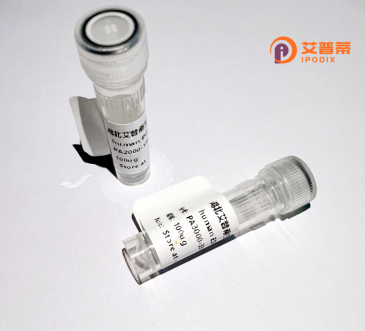
| 纯度 | >90%SDS-PAGE. |
| 种属 | Human |
| 靶点 | F2R |
| Uniprot No | P25116 |
| 内毒素 | < 0.01EU/μg |
| 表达宿主 | E.coli |
| 表达区间 | 1-425aa |
| 氨基酸序列 | MGPRRLLLVAACFSLCGPLLSARTRARRPESKATNATLDPRSFLLRNPNDKYEPFWEDEEKNESGLTEYRLVSINKSSPLQKQLPAFISEDASGYLTSSWLTLFVPSVYTGVFVVSLPLNIMAIVVFILKMKVKKPAVVYMLHLATADVLFVSVLPFKISYYFSGSDWQFGSELCRFVTAAFYCNMYASILLMTVISIDRFLAVVYPMQSLSWRTLGRASFTCLAIWALAIAGVVPLLLKEQTIQVPGLNITTCHDVLNETLLEGYYAYYFSAFSAVFFFVPLIISTVCYVSIIRCLSSSAVANRSKKSRALFLSAAVFCIFIICFGPTNVLLIAHYSFLSHTSTTEAAYFAYLLCVCVSSISCCIDPLIYYYASSECQRYVYSILCCKESSDPSSYNSSGQLMASKMDTCSSNLNNSIYKKLLT |
| 分子量 | 47.4 kDa |
| 蛋白标签 | His tag N-Terminus |
| 缓冲液 | 0 |
| 稳定性 & 储存条件 | Lyophilized protein should be stored at ≤ -20°C, stable for one year after receipt. Reconstituted protein solution can be stored at 2-8°C for 2-7 days. Aliquots of reconstituted samples are stable at ≤ -20°C for 3 months. |
| 复溶 | Always centrifuge tubes before opening.Do not mix by vortex or pipetting. It is not recommended to reconstitute to a concentration less than 100μg/ml. Dissolve the lyophilized protein in distilled water. Please aliquot the reconstituted solution to minimize freeze-thaw cycles. |
以下是关于重组人F2R蛋白(PAR1)的3篇经典文献概览,涵盖分子机制与结构研究:
---
1. **文献名称**:*Molecular Cloning of a Functional Thrombin Receptor Reveals a Novel Proteolytic Mechanism of Receptor Activation*
**作者**:Vu, T.K. et al.
**摘要**:首次成功克隆人凝血酶受体(F2R/PAR1),阐明其通过蛋白酶切割N端产生新表位实现自我激活的独特机制,揭示了PAR1在血小板活化和信号转导中的关键作用。
2. **文献名称**:*Crystal Structure of the Protease-activated Receptor 1 Bound with a Ligand-mimicking Antibody*
**作者**:Zhang, C. et al.
**摘要**:通过X射线晶体学解析重组PAR1胞外结构域与抗体的复合物结构,揭示了受体被激活后构象变化的分子基础,为靶向药物设计提供结构依据。
3. **文献名称**:*Proteinase-Activated Receptors: Transactivation of Endothelial PAR1 by Thrombin Signaling*
**作者**:Coughlin, S.R.
**摘要**:系统综述PAR1通过G蛋白偶联通路介导凝血酶下游效应,阐明其在血栓形成、血管修复及肿瘤微环境调控中的双重作用,探讨其作为治疗靶点的潜力。
---
**研究方向覆盖**:受体克隆与激活机制(Vu, 1991)、结构生物学解析(Zhang, 2012后)及病理生理功能(Coughlin综述)。如需特定领域或最新研究建议,可进一步补充背景信息。
Recombinant human F2R protein, also known as recombinant protease-activated receptor 1 (PAR1), is a genetically engineered form of the human thrombin receptor, a key player in cellular signaling associated with coagulation, inflammation, and cancer progression. PAR1 belongs to the G protein-coupled receptor (GPCR) family and is activated through proteolytic cleavage by serine proteases like thrombin. This cleavage exposes a tethered ligand domain, triggering intracellular signaling cascades (e.g., Gαq, Gα12/13) that regulate platelet activation, endothelial cell function, and tissue repair.
The recombinant F2R protein is typically produced in mammalian or insect expression systems to ensure proper post-translational modifications, such as glycosylation, critical for ligand-binding activity. It is widely used in research to study thrombin-mediated pathways, screen PAR1-targeting therapeutics (e.g., anti-thrombotic drugs), and explore its role in diseases like atherosclerosis, metastatic cancer, and sepsis. Recombinant versions often include tags (e.g., Fc, His) for simplified purification and detection. Recent studies also highlight its potential as a biomarker or therapeutic target in pathologies involving aberrant coagulation or cell proliferation.
×